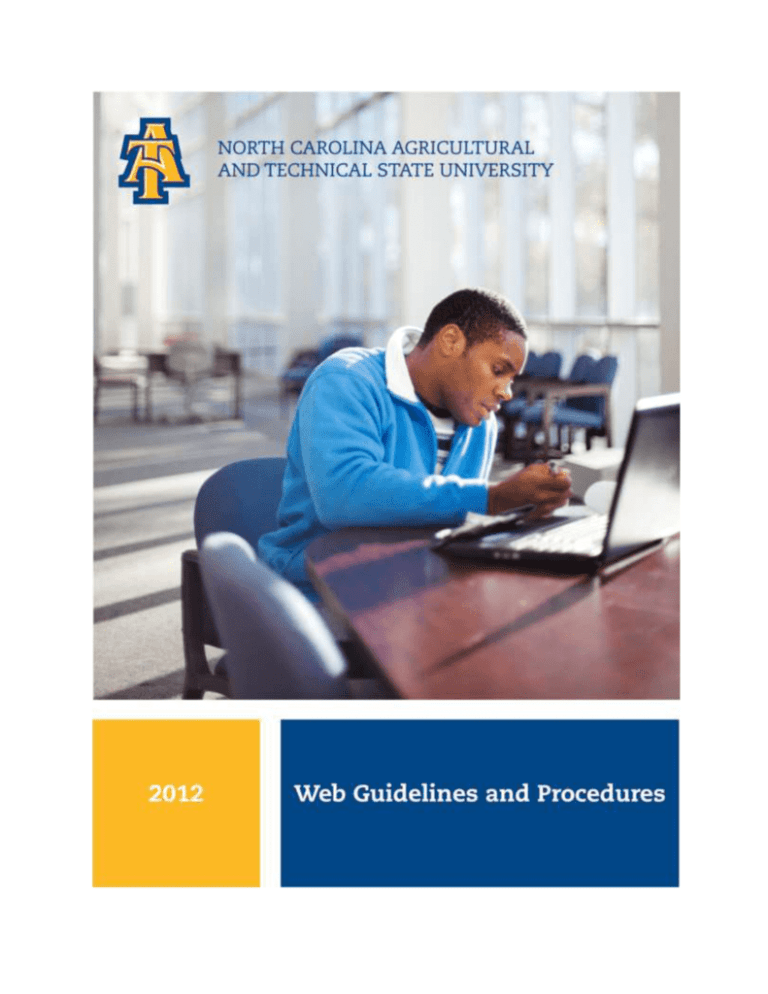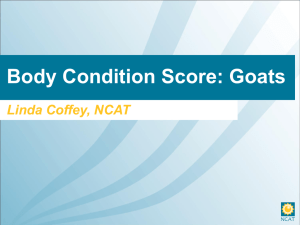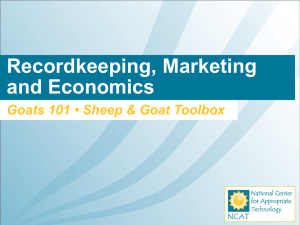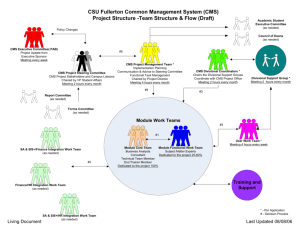NC A&T Web Guidelines & Procedures
advertisement

North Carolina Agricultural and Technical State University Web Guidelines and Procedures Introduction North Carolina Agricultural and Technical State University’s Web presence is a primary communications medium used to promote and enhance the university’s image by providing relevant and up-to-date information about our programs, research, services, and accomplishments. University Relations is responsible for executing and coordinating Web communications for the university. As part of these duties, this office is charged with: Creating a Web identity that captures the unique brand characteristics of North Carolina A&T State University Ensuring that the Web site reinforces and effectively supports the university’s marketing messages and university goals outlined in North Carolina A&T State University’s 2020 Preeminence Strategic Plan Ensuring the Web site addresses audience needs and meets high standards of written and visual content and ease of navigation Coordinating with the Division of Information Technology to provide up-to-date Web site tools for Web site administrators and Web coordinators to manage and author sites within the ncat.edu domain What is Your Purpose? The first thing to consider when maintaining a web site is what the primary purpose will be. Once you establish a purpose for providing content to your web site, then you are well on your way. Next, identify who your audience is (prospective students, current students, parents, alumni, etc.). What types of information will they be looking for when they visit your web page? Put yourself in the seat of the end-user and you will begin to identify their needs. For more detailed information call the University Relations web manager for helpful hints and guidelines. Some Rules of Good Navigation You should always be able to easily navigate throughout your web site and get to documents with minimum difficulty. Always provide access to the original table of contents, or its equivalent. Your "table of contents" in this context is the set of categories, or main topic areas, that you came up with in the first stage of your web planning. This set of categories should be available to the web surfer from anywhere within your web site. If visitors to your site have to use the BACK button several times to go back to the main links, you will lose them. Your site should be so easy to navigate that the BACK button will only need to be used once at a time, if at all. User Experience The purpose of policies and procedures around user experience is to bring a clear, consistent, and user friendly face to N.C. A&T State University’s web presence. By striving towards the goal of a unified web identity, several key benefits can be gained, such as: • Consistent user experience across all N.C. A&T sites • A unified vision of what each web site should look like means users can tell, at a glance, that they are on a University property and also instantly know how to navigate and use the site. • A unified identity means that multiple web sites are easier to maintain and components can easily be used across web sites. This decreases cost and development time. • A unified data organization scheme means that data can be accessed in a standard way, across multiple sites. This aids communication and interoperability. Information The purpose of policies and procedures around information is to provide consistent, accurate, current and secured information to users of N.C. A&T State University web sites. This will provide several benefits such as: • Accurate, current and consistent information across N.C. A&T State University web sites • A unified data organization scheme with data that can be accessed in a standard way, across multiple sites. This aids communication and interoperability. • Information that is secured and complies with organizational policies • Reducing risks to the organization, its constituents and stakeholders Standards and Related Policies All university Web pages must comply with local, state, and federal laws and N.C. A&T State University’s existing policies and procedures. To ensure that the university is represented with integrity and consistency, all pages must also meet the standard N.C. A&T State University Web criteria outlined or referenced below: • Information Security Plan: N.C. A&T State University has established a specific policy applicable to the technology arena. Appropriate use of computing and networking resources and insuring the integrity of data and privacy is everybody’s responsibilities. Technological and information resources and the access provided by the University to campus resources are to be governed by this plan. o The Information Security Plan applies to technology administered by individual departments, to student owned hardware connected to the campus network, to the resources administered by central administrative departments such as University Libraries or Computing and Information Technology, and to actions originating from computer systems maintained by members of the campus community offcampus which connect remotely to the University's network services. o The Information Security Plan applies to all systems owned, managed or administered by the University and any use of those systems. Many specific areas and/or systems may have service-specific policies that apply in addition to this umbrella plan. Please refer to the entire document found at Information Security Plan. • Branding Guidelines: The N.C. A&T State University Web site is one of the key places audiences can learn about the university and form an impression of the institution. N.C. A&T Web pages must review and adhere to the N.C. A&T State University’s Style Guide. • Editorial Style: Web coordinators and contributors responsible for preparing text and visual graphics for Web pages must consult the N.C. A&T State University Style Guide. It details the correct way to reference how the university name should be written (first, second, third reference) and the proper use of the seal, logos and word marks. • HTML Typefaces– Web coordinators and contributors will receive access to pre-coded templates and will not have to make any determinations on typeface. However, for details on N.C. A&T’s color specification chart and primary typefaces refer to the Style Guide. • University Official Colors: The official university colors should be the most dominant colors on any of the university sites. They should anchor all Web site designs. The Pantone Color Matching System (PMS) codes are PMS 288 (blue) and PMS 123 (gold). • Privacy and Collection of Personal or Confidential Information: Individuals responsible for Web pages within each department should become familiar with the university’s Web Privacy Policy. The purpose of this policy is to disclose the terms governing the collection and use of information obtained from visits to the University home website www.ncat.edu. o Internal: The privacy policies for University administrative, academic, and operational entities such as offices, divisions, departments, units, and organizations may vary from this policy. Visitors are responsible for consulting the privacy policies for University administrative, academic, and operational websites. o External/Third Party: The privacy policies for external and/or third party websites accessible from the University home website are not governed by this policy, meaning these entities have their own privacy policies. Visitors are responsible for consulting the privacy policies for external and/or third party web sites. • Copyright: Licensing approval is not required for internal, non-commercial university use of trademarks on stationery, brochures, reports, etc. However, all users must adhere to the guidelines of this style manual. The Office of Legal Affairs provides guidance in selecting the appropriate and legal means for reproducing material in accordance with the current laws. For additional copyright information, contact the Office of Legal Affairs. • Advertising: Advertising on the Web site within the ncat.edu domain is prohibited. Alternative consideration can be given to sponsors. For questions, contact Nicole Pride, Associate Vice Chancellor for University Relations. • URLs: Official N.C. A&T State University sites should have a URL that is intuitive and reflective of an academic or administrative unit’s affiliation with the university. University Relations recommends that all units adopt a domain name that is brief and marketable. Examples: o Preferred: http://www.ncat.edu/architecture o Preferred: http://architecture.ncat.edu • Web sites of official N.C. A&T State University units must reside in the ncat.edu domain, unless approval is granted from University Relations. For questions, contact Nicole Pride, Associate Vice President for University Relations. Web Content Management System (CMS) Procedures To assist the University web manager in managing university web site content, as well as, provide consistency in organization and appearance of the N.C. A&T State University web site, the university uses a Web content management system (CMS) for official university Web sites. Pages within the CMS are designed to be compatible with a variety of popular web browsers and devices, accessible for persons with disabilities in accordance with Section 508 of the federal Rehabilitation Act of 1973 (29 U.S.C. 794d) and adherent to industry Web design standards, as well as N.C. A&T State University standards. Editors using the CMS are then free to concentrate on developing content and features for their audiences, rather than get bogged down with the technical aspects of Web site construction. University Relations is responsible for coordinating with departments and units to move sites into and maintain sites within the CMS. N.C. A&T State University Web sites and pages should be maintained with the following principles in mind: User-centric design Through every step of Web design and development, consider the needs, goals and expectations of your site’s users. Clearly define and prioritize your audiences. Then design the content, layout, organization, navigation, structure and functionality for those audiences. Maintaining While individual units are responsible for keeping their sites up-to-date, University Relations will continue to review Web sites and offer ongoing information and advice to assist Web site managers. Brand consistency Make sure your users know your site is part of N.C. A&T State University. Design Web sites in such a way that every element of the site supports the university brand. Contact the Web Manager at 336.256.0863. Strong content Content is the heart and soul of every Web site. Without it, most sites wouldn’t exist. Create content that is engaging, interesting, up-to-date, accurate, on-brand and most importantly, relevant and valuable to your audiences. Usability Think about what your users want from your site. Consider how they want it to work, what words and language resonate and what information is most important to them. Make every element of the site intuitive for your users (not just for the site’s designers or department heads). Visual Images Most people prefer attractive sites, but they must also be functional. Good images and video should be carefully considered when adding to your page. Accessibility (Section 508 compliance) Like our university, our users are diverse. Site content needs to be accessible and useful to all of those users. N.C. A&T is committed to delivering accessible Web sites, and requires that sites comply with requirements outlined in Section 508 of the federal Rehabilitation Act of 1973. [CW: I think a link to some how-to guide is essential. I doubt that many people know how to make Web sites accessible to the disabled.] Sustainability Keeping sites fresh and accurate requires consistent updates, revisions and modifications. Sites should be built for simple, efficient management and evolution. Web management tools should be chosen based on the needs of the sites’ managers and contributors, not simply the Web developers or programmers. CMS Roles and Requirements of CMS Users Web Manager: Each site within the CMS is managed by the University Web Manager located within the Office of University Relations. This person is responsible for overseeing Web maintenance and development of the site and interfacing with the University Relations Web team. All Web coordinators and content contributors report directly to the Web Manager regarding Web site usage. Web Content Contributors are expected to: • Organize their web sites in keeping with the practices defined at top levels of the A&T website. • Edit and update existing content within their area of the web site. • Create new pages of content as needed. • Populate pages with photography and video. • Add relevant event information to the University calendar. • Review web site analytics reports that provide insight into how their content is being used or ignored. Web Content Coordinators are expected to: • Work with Web Content Contributors to ensure that their efforts remain strategic and on message. • Support, encourage and cajole the Contributors within their purview. • Review, edit and approve content created by Contributors. • Create website analytics reports and deliver to Contributors. • Categorize and tag content for re-use across the University. • Curate news, events and feature stories for placement on high-level pages of the website. • Collaborate with University Relations and Division of Information Technology (DoIT) on the build-out of new website functionality. Requirements for Web Content Coordinators and Content Contributors Staff, faculty, or students assigned to creating and/or maintaining Web pages for university units will be required to attend the following training sessions before given access to the CMS: Communications and Web guidelines training by University Relations Acknowledgement that web coordinators and assistants understand and will abide by the policies and procedures in this document Review of Web Sites Before a site within the CMS can go live, it must be approved by University Relations to make sure it adheres to policies and guidelines outlined in this document. After the launch of a unit’s Web site, University Relations web manager will review content posted to the site to ensure its editorial and information accuracy and adherence to University branding guidelines. This review will take place after content is live on the N.C. A&T State University site so as not to slow down the dissemination of timely and accurate information. Termination of Link N.C. A&T State University reserves the right to refuse to provide a link on an official university web page and to remove a link without notice. Content and/or links to areas found to be in violation of university policies, or local, state, or federal laws, will be immediately terminated. The following reasons are also grounds for termination of employment: • Content on official university Web sites does not adhere to the university's mission or policies. • Content violates United States copyright laws. To use copyrighted material including text, graphics, photographs, sound and video clips, and software on a site within the ncat.edu domain, the site developer must obtain and retain on file written permission for each use from the originating author or creator. • Content is obscene, offensive, or threatening. • Content is designed for private financial gain or compensation not relevant to the mission of the university or in violation of other official university policy, and restrictions for nonprofit organizations. • Content is used to intimidate or single out an individual or group for degradation or harassment in violation of federal or state law and official university policy. • Content is used to engage in or solicit any illegal activity in violation of federal or state law or official university policy. • University Relations upon correction of the infraction(s) may reactivate a terminated link upon review.




